Add a content module to a Brightspace course
Jump to navigation
Jump to search
About this article
This article demonstrates how to add a content module to a table of contents (TOC) in a Brightspace course. It is intended for instructors.
What's a module?
In D2L, instructors provide students with access to course materials by building a TOC composed of headings and links. The headings are called modules and the links are called topics. There are many ways to organize content and any TOC could include a combination of approaches. For example, instructors could organize content by:
- Timeline. Modules represent some unit of time (e.g., Week 1, Week 2).
- Subject. Modules represent chapters or subject areas in textbook fashion (e.g., Biological Bases of Behavior)
- Type. Modules group content based on type (e.g., handouts, slides, videos, links).
Instructions
For all instructions below, first navigate to a D2L course and select Content from the Materials menu. This will take you to the D2L Content Tool.
Adding a module
- At the bottom of the sidebar region, select Add a module... (Figure 1.2).
- Enter a title for the new module and press Enter on your keyboard.
Adding a sub-module
- From the sidebar region, select the module or sub-module under which you want to place a sub-module.
- At the bottom of this module, select Add a sub-module....
- Enter a title for the new sub-module, and press Enter on your keyboard.
Renaming a module or sub-module
- From the sidebar region, select the module or sub-module that you want to rename.
- Select the title of the module or sub-module at the top of the content region (Figure 4).
- Change the title and select Enter on your keyboard to save it.
Adding a description to a module or sub-module
- From the sidebar region, select the module or sub-module that you want to rename.
- Select Add a description... on the content region (Figure 5).
- Use the editor to create the description and select the Update button to save it.
Additional details
- New modules and sub-modules are always added to the end of the list. They can then be moved if needed.
- It's good practice to keep module and sub-module titles short so they fit on the sidebar. Titles longer than 16 characters (including spaces) will wrap to a second line.
- By default, new modules are set to visible mode and access is unrestricted. You can control access by switching to Draft mode or by setting restrictions at the module-level (e.g., if you don't want students to see a module until after a certain point in the course). This will restrict access to all of the sub-modules and topics underneath it.
- Module and sub-module descriptions can help orient students and give your TOC a polished look.
- If you plan to import a publisher-provided course pack or cartridge, it is not uncommon for that process to result in the addition of several new modules and sub-modules. For example, the publisher may include links to PowerPoint slides under a "PowerPoint Presentations" module. This import can be done at any time, even if you have already added modules yourself. Any new modules created by the installation of a course pack are typically added at the bottom of your existing TOC. These modules can then be edited, moved, or deleted.
- If you are going to merge course sections, do not create modules until after the merge is complete and the new merged course appears on your class list.
- Be careful when deleting modules and sub-modules. Depending on how you delete the module, you may also delete child sub-modules and topics.
